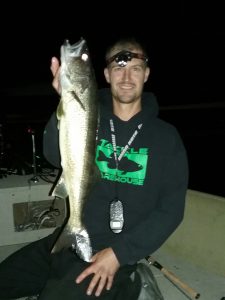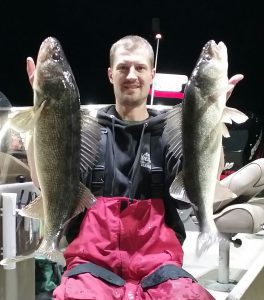Editors Note: Today we welcome a new sports feature about fishing from guest columnist Joe Greco. It’s a favorite leisure time activity for many people, including yours truly. Joe is a NYS licensed guide fishing part-time with Justy-Joe sportfishing charters (newyorkfishing.com). He is also works full-time as a production Chef at Skidmore college and lives in Saratoga county with his two children Charlotte and Avery. Hope you enjoy!

There is just something about being in the outdoors at night. Don’t get me wrong, being outdoors anytime is what I live for, but I am a particular fan of night fishing. At night, there’s no pressure to be anywhere. Most people are settling down for the night and the boat traffic is now where to be found. Jet skis are not flying by you a hundred miles an hour and the beating sun has given way to a calming moon or star filled sky. It may seem like theres not much at all going on, however the fish have proven to show us otherwise.
Under the cover of darkness lurk many hungry predators, setting up shop on various points of ambush awaiting a vulnerable meal. Several species will feed actively at night providing angling opportunities for those that may be busy during the daylight hours with other obligations. There’s always time for fishing and sometimes you just need to know where to look.
My favorite species to target at night is the elusive walleye. Many local lakes and rivers that have good populations of walleye such as Great Sacandaga, Tomhannock Reservoir, Saratoga Lake, Mohawk and Hudson Rivers as well as a few smaller lakes and ponds in the Adirondacks.
The best time of year for this is usually in the spring, just after the season opens and then again in the late fall. Water temperature and other environmental factors will trigger these late night feeding binges that help the fish either with egg production or with recouping from the rigors of the spring spawn. We target these fish in relatively shallow areas that are holding baitfish, rocks and oxygen rich vegetation. You need to do a little scouting to locate these areas and often times a “hit and run” approach is best to eliminate non-productive areas quickly.
Locating structure is critical and can be done easily now with the available sonar technology brought to us by today’s leading manufacturers. It is essential to understand your fish finder and become familiar with the various color schemes and what they mean when trying to locate weeds, rocks and fish. The new Humminbird Helix units offer Anglers cutting-edge technology at a very reasonable price. These units combine state of the art sonar and GPS technology to help you understand where you are fishing and keep you on the spot.
I am always looking for changes in bottom composition, which can mean color changes on your sonar unit. Hard bottom often appears as blues and blacks and softer bottom, such as weed growth, can be seen in reds and yellows. Using the new down/side imaging technology you can actually verify wood, weeds and other structure. This new technology “scans” the bottom giving you a photo-like image in real time showing you wood pilings, weeds and other sunken treasures like bridges and old wrecks. Make sure to save them as waypoints so you can return to them at night when out fishing.
So now you’ve found the spot and you’re ready to fish, what next? Techniques will vary from season to season as conditions change. The metabolism of the fish will be at high speed during warm summer months and slow down dramatically during the fall of the year. All these factors will determine what to use and when. In the summertime I love to fish inline spinners. These are usually hand-tied harnesses that will be rigged with either live bait or a variety of plastics. Gulp! Minnows, leeches and worms are tough to beat. Their quick spinning blades sneak and slide their way through weed growth, which in many instances can be unavoidable.
I will troll them slowly or cast and retrieve the around various points of structure until I locate fish. If one spot produces nothing, I move onto the next. During the late fall and early winter, casting begins to take precedence as fish will slide into very shallow areas making trolling difficult. Suspending style stick baits made by a variety of companies such as Lucky craft, Rapala and Smithwick are my go to baits as they can be fished very slowly and left to rest motionless which often will trigger a strike.
I will make several casts on each spot before moving. If I catch one fish I know there’s probably more, this being the que to slow down and fish the area more meticulously trying a variety of retrieves and colors. It’s important to find “what they want” on each given night which can vary depending on the attitude of the fish.
Night fishing can be a great time, but it can also test you mentally and physically. Many nights are very cold and can be very dark, especially if heavy cloud cover prevails. This means the Angler must leave the dock well prepared and make sure headlamps, good navigational lights, and the appropriate safety gear are available and in good working order.
Mentally this game can also wear you out, as after a few fruitless casts the thought of being home in a warm bed or back the house watching the tube can be quite tempting. You need to tell yourself that the big fish are out, and it’s only a matter of time before you “crack the code.” Persistence is a key here.

The good news is that you will most likely have the place to yourself. I can recall a few outings last fall when there wasn’t a soul out anywhere and I was crushing them on what seemed like every cast. I had been turned down after asking several of my deer hunter buddies to join me that night (as deer season typically takes priority this time of year), and it was just me and the fish.
So, if you’re looking for a little different angling experience, give the “night shift” a chance. You may be surprised at the numbers of fish you will catch as well as the number of different species that come out at night and do their thing. Remember safety first! Being familiar with the body of water you are planning on fishing is obviously very important. Bring safety gear such as lighting, flotation devices and basic distress signals should be brought and be readily available. Good luck out there, be safe and crack the code!
Joe Greco
March 8, 2017



